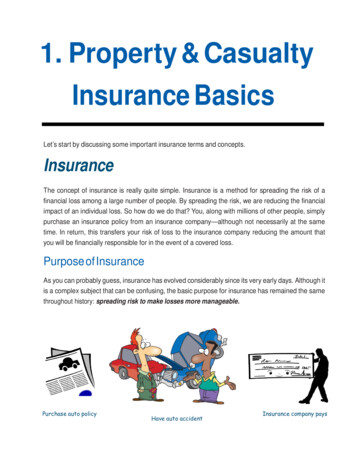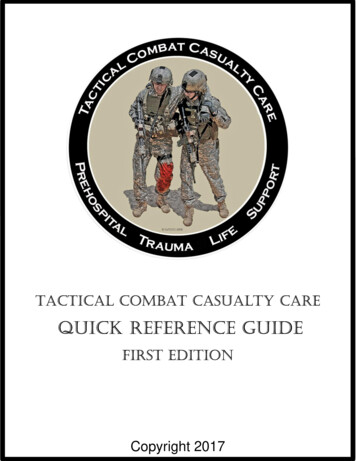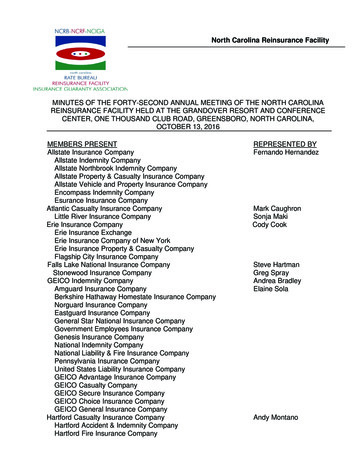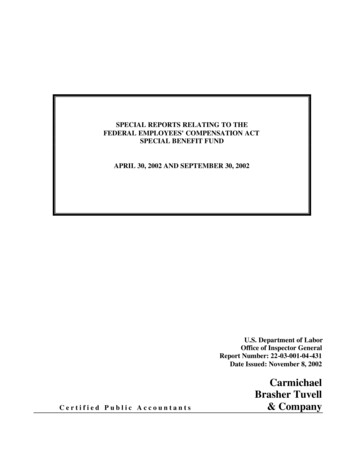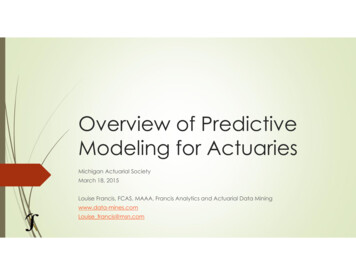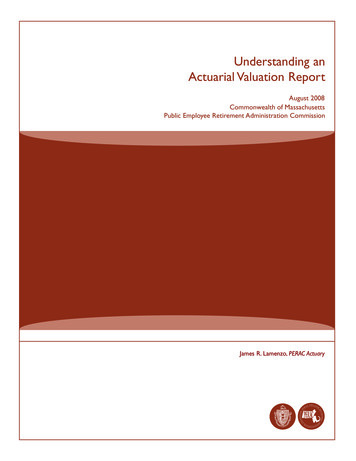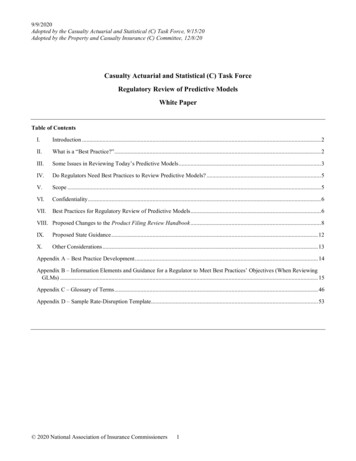
Transcription
9/9/2020Adopted by the Casualty Actuarial and Statistical (C) Task Force, 9/15/20Adopted by the Property and Casualty Insurance (C) Committee, 12/8/20Casualty Actuarial and Statistical (C) Task ForceRegulatory Review of Predictive ModelsWhite PaperTable of ContentsI.Introduction . 2II.What is a “Best Practice?” . 2III.Some Issues in Reviewing Today’s Predictive Models . 3IV.Do Regulators Need Best Practices to Review Predictive Models? . 5V.Scope . 5VI.Confidentiality . 6VII.Best Practices for Regulatory Review of Predictive Models . 6VIII. Proposed Changes to the Product Filing Review Handbook . 8IX.Proposed State Guidance . 12X.Other Considerations . 13Appendix A – Best Practice Development . 14Appendix B – Information Elements and Guidance for a Regulator to Meet Best Practices’ Objectives (When ReviewingGLMs) . 15Appendix C – Glossary of Terms . 46Appendix D – Sample Rate-Disruption Template. 53 2020 National Association of Insurance Commissioners1
9/9/2020Adopted by the Casualty Actuarial and Statistical (C) Task Force, 9/15/20Adopted by the Property and Casualty Insurance (C) Committee, 12/8/20I.INTRODUCTIONInsurers’ use of predictive analytics along with big data has significant potential benefits to both consumers and insurers.Predictive analytics can reveal insights into the relationship between consumer behavior and the cost of insurance, lowerthe cost of insurance for many, and provide incentives for consumers to better control and mitigate loss. However,predictive analytic techniques are evolving rapidly and leaving many state insurance regulators, who must review thesetechniques, without the necessary tools to effectively review insurers’ use of predictive models in insurance applications.When a rate plan is truly innovative, the insurer must anticipate or imagine the reviewers’ interests because reviewers willrespond with unanticipated questions and have unique educational needs. Insurers can learn from the questions, teach thereviewers, and so forth. When that back-and-forth learning is memorialized and retained, filing requirements and insurerpresentations can be routinely organized to meet or exceed reviewers’ needs and expectations. Hopefully, this white paperhelps bring more consistency to the art of reviewing predictive models within a rate filing and make the review processmore efficient.The Casualty Actuarial and Statistical (C) Task Force has been charged with identifying best practices to serve as a guideto state insurance departments in their review of the predictive models 1 underlying rating plans. There were two chargesgiven to Task Force by the Property and Casualty Insurance (C) Committee at the request of the Big Data (EX)Working Group: Draft and propose changes to the Product Filing Review Handbook to include best practices for review ofpredictive models and analytics filed by insurers to justify rates. Draft and propose state guidance (e.g., information, data) for rate filings based on complex predictivemodels.This white paper will identify best practices for the review of predictive models and analytics filed by insurers withregulators to justify rates and will provide state guidance for the review of rate filings based on predictive models. Uponadoption of this white paper by the Executive (EX) Committee and Plenary, the Task Force will make a recommendationto incorporate these best practices into the Product Filing Review Handbook and will forward that recommendation to theSpeed to Market (EX) Working Group.As discussed further in the body of the white paper, this document is intended as guidance for state insurance regulatorsas they review predictive models. Nothing in this document is intended to, or could, change the applicable legal andregulatory standards for approval of rating plans. This guidance is intended only to assist state insurance regulators as theyreview models to determine whether modeled rates are compliant with existing state laws and/or regulations. To the extentthese best practices are incorporated into the Product Filing Review Handbook, the handbook provides that it is intendedto “add uniformity and consistency of regulatory processes, while maintaining the benefits of the application of uniquelaws and regulations that address the state-specific needs of the nation’s insurance consumers.”II. WHAT IS A “BEST PRACTICE”?A best practice is a form of program evaluation in public policy. At its most basic level, a practice is a “tangible and visiblebehavior [based on] an idea about how the actions will solve a problem or achieve a goal.” 2 Best practices are used tomaintain quality as an alternative to mandatory legislated standards and can be based on self-assessment or benchmarking. 3Therefore, a best practice represents an effective method of problem solving. The “problem” regulators want to solve isprobably better posed as seeking an answer to this question: How can regulators determine whether predictive models, asused in rate filings, are compliant with state laws and/or regulations?In this white paper, references to “model” or “predictive model” are the same as “complex predictive model” unless qualified.Bardach, E., and Patashnik, E., 2016. A Practical Guide for Policy Analysis, The Eightfold Path to More Effective Problem Solving. Thousand Oaks, CA:CQ Press. See Appendix A for an overview of Bardach’s best-practice analysis.3Bogan, C.E., and English, M.J., 1994. Benchmarking for Best Practices: Winning Through Innovative Adaptation. New York, NY: McGraw-Hill.12 2020 National Association of Insurance Commissioners2
9/9/2020Adopted by the Casualty Actuarial and Statistical (C) Task Force, 9/15/20Adopted by the Property and Casualty Insurance (C) Committee, 12/8/20Key Regulatory PrinciplesIn this white paper, best practices are based on the following principles that promote a comprehensive and coordinatedreview of predictive models across the states:1.State insurance regulators will maintain their current rate regulatory authority and autonomy.2.State insurance regulators will be able to share information to aid companies in getting insurance products tomarket more quickly across the states. 43.State insurance regulators will share expertise and discuss technical issues regarding predictive models to makethe review process in any state more effective and efficient.4.State insurance regulators will maintain confidentiality, in accordance with state law, regarding predictive models.Best practices are presented to state insurance regulators for the review of predictive models and to insurance companiesas a consideration in filing rating plans that incorporate predictive models. As a byproduct of identifying these bestpractices, general and specific information elements were identified that could be useful to a regulator when reviewing arating plan that is wholly or in part based on a generalized linear model (GLM). For the states that are interested, theinformation elements are identified in Appendix B, including comments on what might be important about that informationand, where appropriate, providing insight as to when the information might identify an issue the regulator needs to beaware of or explore further. Lastly, provided in this white paper are glossary terms (see Appendix C) and references(contained in the footnotes) that can expand a state insurance regulator’s knowledge of predictive models(GLMs specifically).III. SOME ISSUES IN REVIEWING TODAY’S PREDICTIVE MODELSThe term “predictive model” refers to a set of models that use statistics to predict outcomes. 5 When applied to insurance,the model is chosen to estimate the probability or expected value of an outcome given a set amount of input data; forexample, models can predict the frequency of loss, the severity of loss, or the pure premium. The GLM 6 is a commonlyused predictive model in insurance applications, particularly in building an insurance product’s rating plan.Depending on definitional boundaries, predictive modeling can sometimes overlap with the field of machine learning. Inthis modeling space, predictive modeling is often referred to as predictive analytics.Before GLMs became vogue, rating plans were built using univariate methods. Univariate methods were consideredintuitive and easy to demonstrate the relationship to costs (loss and/or expense). Today, many insurers consider univariatemethods too simplistic because they do not take into account the interaction (or dependencies) of the selected inputvariables.Today, the majority of predictive models used in personal automobile and home insurance rating plans are GLMs. 7According to many in the insurance industry, GLMs introduce significant improvements over univariate-based rating plansby automatically adjusting for correlations among input variables. However, it is not always easy to understand thecomplex predictive model output’s relationship to cost. This creates a problem for the state insurance regulator when modelresults are difficult to explain to someone (e.g., a consumer) who has little to no expertise in modeling techniques.The states can share information if they can maintain confidentiality and legally share such information. Information about a classification plan documentedin one state could be shared with another state.A more thorough exploration of different predictive models will be found in many books on statistics, including: Geisser, S., 2016. Predictive Inference: An Introduction, New York, NY: Chapman & Hall. James, G., et al., 2017. An Introduction to Statistical Learning: with Applications in R, New York, NY: Springer Science Business Media, pp. 87–90.Accessed online at SLR%20Seventh%20Printing.pdf.6The GLM is a flexible family of models that are unified under a single method. Types of GLMs include logistic regression, Poisson regression, gammaregression, and multinomial regression.7Goldburd, M., et al., 2016. “Generalized Linear Models for Insurance Rating,” CAS Monograph Series, Number 5, Second Edition, pp. 52–58. Accessedonline at Khare-Tevet.pdf.45 2020 National Association of Insurance Commissioners3
9/9/2020Adopted by the Casualty Actuarial and Statistical (C) Task Force, 9/15/20Adopted by the Property and Casualty Insurance (C) Committee, 12/8/20Generalized Linear ModelsA GLM consists of three elements: 8 A target variable, Y, which is a random variable that is independent and is assumed to follow a probabilitydistribution from the exponential family, defined by a selected variance function and dispersion parameter. A linear predictor, η Xβ. A link function g, such that E(Y) μ g 1(η).As can be seen in the description of the three GLM components above, it may take more than a casual introduction tostatistics to comprehend the construction of a GLM. As stated earlier, a downside to GLMs is that it is more challengingto interpret a GLM’s output than that of a univariate model.To further complicate the regulatory review of models in the future, modeling methods are evolving rapidly and are notlimited just to GLMs. As computing power grows exponentially, it is opening the modeling world to more sophisticatedforms of data acquisition and data analysis. Insurance actuaries and data scientists seek increased predictiveness by usingeven more complex predictive modeling methods. Examples of these methods include predictive models utilizing randomforests, decision trees, neural networks, or combinations of available modeling methods (often referred to as “ensembles”).These evolving techniques will make a state insurance regulator’s understanding and oversight of filed rating plans thatincorporate predictive models even more challenging.In addition to the growing complexity of predictive models, many state insurance departments do not have in-houseactuarial support or have limited resources to contract out for support when reviewing rate filings that include the use ofpredictive models. The Big Data (EX) Working Group identified the need to provide the states with guidance and assistancewhen reviewing predictive models underlying filed rating plans. 9 The Working Group circulated a proposal addressing aidto state insurance regulators in the review of predictive models as used in personal automobile and home insurance ratefilings. This proposal was circulated to all Working Group members and interested parties on Dec. 19, 2017, for a publiccomment period ending Jan. 12, 2018. 10 The Working Group’s effort resulted in new charges for the Casualty Actuarialand Statistical (C) Task Force (see Section I—Introduction) to identify best practices that provide guidance to the states intheir review of predictive models.Credibility of GLM OutputIf the underlying data is not credible, then no model will improve that credibility, and segmentation methods could makecredibility worse. GLM software provides point estimates and allows the modeler to consider standard errors andconfidence intervals. GLMs effectively assume that the underlying datasets are 100% credible, no matter their size. If somesegments have little data, the resulting uncertainty would not be reflected in the GLM parameter estimates themselves(although it might be reflected in the standard errors, confidence intervals, etc.). Even though the process of selectingrelativities often includes adjusting the raw GLM output, the resultant selections are typically not credibility-weighted withany complement of credibility. 11,12 And, selected relativities based on GLM model output may differ from GLM pointestimates. Lack of credibility for particular estimates could be discerned if standard errors are large relative to the pointestimates and/or if the confidence intervals are broad.Because of this presumption in credibility, which may or may not be valid in practice, the modeler—and the state insuranceregulator reviewing the model—would need to engage in thoughtful consideration when incorporating GLM output into arating plan to ensure that model predictiveness is not compromised by any lack of actual credibility. Another considerationis the availability of data, both internal and external, that may result in the selection of predictor variables that have spuriousInformation on model elements can be found in most books on statistics.Big Data (EX) Working Group March 24, 2018, minutes (see NAIC Proceedings – Spring 2018, Innovation and Technology (EX) Task Force,Attachment Two). Accessed online at https://www.naic.org/prod serv/PRC-ZS-18-01.pdf.10All comments received by the end of January 2018 were posted to the NAIC website March 12, 2018, for review.11Sometimes insurers do review complements of credibility and further weight the GLM output with those complements. While this may not be a standardpractice today, new techniques could result in this becoming more standard in the future.12GLMs provide confidence intervals, credibility methods do not. There are techniques such as penalized regression that blend credibility with a GLM andimprove a model’s ability to generalize.89 2020 National Association of Insurance Commissioners4
9/9/2020Adopted by the Casualty Actuarial and Statistical (C) Task Force, 9/15/20Adopted by the Property and Casualty Insurance (C) Committee, 12/8/20correlation with the target variable. Therefore, to mitigate the risk that model credibility or predictiveness is lacking, acomplete filing for a rating plan that incorporates GLM output should include validation evidence for the rating plan, notjust the statistical model.IV. DO REGULATORS NEED BEST PRACTICES TO REVIEW PREDICTIVE MODELS?It might be better to revise the question of “Do regulators need best practices to review predictive models?” to “Are bestpractices in the review of predictive models of value to regulators and insurance companies?” The answer is “yes” to bothquestions.Regulatory best practices need to be developed that do not unfairly or inordinately create barriers for insurers, andultimately consumers, while providing a baseline of analysis for state insurance regulators to review the referenced filings.Best practices will aid regulatory reviewers by raising their level of model understanding. Also, with regard to scorecardmodels and the model algorithm, there is often not sufficient support for relative weight, parameter values, or scores ofeach variable. Best practices can potentially aid in addressing this problem.Best practices are not intended to create standards for filings that include predictive models. Rather, best practices willassist the states in identifying the model elements they should be looking for in a filing that will aid the regulator inunderstanding why the company believes that the filed predictive model improves the company’s rating plan and, therefore,makes that rating plan fairer to all consumers in the marketplace. To make this work, state insurance regulators and theindustry need to recognize that: Best practices provide guidance to state insurance regulators in their essential and authoritative role over the ratingplans in their respective state. Every state may have a need to review predictive models, whether that occurs during the approval process of arating plan or during a market conduct exam. Best practices help the state insurance regulator identify elementsof a model that may influence the regulatory review as to whether modeled rates are appropriately justified,compliant with state laws and/or regulations, and whether to act on that information. Best practices provide a framework for the states to share knowledge and resources to facilitate the technicalreview of predictive models. Best practices can lead to improved quality in predictive model reviews across the states, aiding speed to marketand competitiveness of the state’s insurance marketplace. Best practices aid training of new state insurance regulators and/or regulators new to reviewing predictive models.This is especially useful for those regulators who do not actively participate in NAIC discussions related to thesubject of predictive models. Each state insurance regulator adopting best practices will be better able to identify the resources needed to assisttheir state in the review of predictive models.V. SCOPEThe best practices identified in this white paper were derived from a ground-up study and analysis of how GLMs are usedin personal automobile and home insurance rating plans. These three components (GLM, PPA, and HO) were selected asthe basis to develop best practices for the regulatory review of predictive models because many state insurance regulatorsare familiar with, and have expertise in, such filings. In addition, the legal and regulatory constraints (including statevariations) are likely to be more evolved, and challenging, for personal automobile and home insurance. It is through areview of these personal lines and the knowledge needed to review GLMs 13 used in their rate filings that will providemeaningful best practices for state insurance regulators. The identified best practices should be readily transferrable whenthe review involves other predictive models applied to other lines of business or for an insurance purpose other than rating.13See Appendix B. 2020 National Association of Insurance Commissioners5
9/9/2020Adopted by the Casualty Actuarial and Statistical (C) Task Force, 9/15/20Adopted by the Property and Casualty Insurance (C) Committee, 12/8/20VI. CONFIDENTIALITYEach state determines the confidentiality of a rate filing and the supplemental material to the filing, when filing informationmight become public, the procedure to request that filing information be held confidentially, and the procedure by whicha public records request is made. Regulatory reviewers are required to protect confidential information in accordance withapplicable state law. State insurance regulators should be aware of their state laws on confidentiality when requesting datafrom insurers that may be proprietary or a trade secret. However, insurers should be aware that a rate filing might becomepart of the public record. It is incumbent on an insurer to be familiar with each state’s laws regarding the confidentialityof information submitted with its rate filing.State authority, regulations and/or rules governing confidentiality always apply when a state insurance regulator reviewsa model used in rating. When the NAIC or a third party enters the review process, the confidential, proprietary, and tradesecret protections of the state on behalf of which a review is being performed will continue to apply.VII. BEST PRACTICES FOR THE REGULATORY REVIEW OF PREDICTIVE MODELSBest practices will help the state insurance regulator understand if a predictive model is cost-based, if the predictive modelis compliant with state law, and how the model improves a company’s rating plan. Best practices can also improve theconsistency among the regulatory review processes across the states and improve the efficiency of each regulator’s review,thereby helping companies get their products to market faster. With this in mind, the regulator’s review of predictivemodels should:1.2.3.Ensure that the selected rating factors, based on the model or other analysis, produce rates that are not excessive,inadequate, or unfairly discriminatory.a.Review the overall rate level impact of the proposed revisions to rate level indications provided by the filer.b.Determine whether individual input characteristics to a predictive model and their resulting rating factors arerelated to the expected loss or expense differences in risk.c.Review the premium disruption for individual policyholders and how the disruptions can be explained toindividual consumers.d.Review the individual input characteristics to, and output factors from, the predictive model (and its submodels), as well as associated selected relativities, to ensure they are compatible with practices allowed inthe state and do not reflect prohibited characteristics.Obtain a clear understanding of the data used to build and validate the model, and thoroughly review all aspectsof the model, including assumptions, adjustments, variables, sub-models used as input, and resulting output.a.Obtain a clear understanding of how the selected predictive model was built.b.Determine whether the data used as input to the predictive model is accurate, including a clear understandinghow missing values, erroneous values, and outliers are handled.c.Determine whether any adjustments to the raw data are handled appropriately, including, but not limited to,trending, development, capping, and removal of catastrophes.d.Obtain a clear understanding of how often each risk characteristic used as input to the model is updated andwhether the model is periodically refreshed, to help determine whether the model output reflects changes tonon-static risk characteristics.Evaluate how the model interacts with and improves the rating plan.a.Obtain a clear understanding of the characteristics that are input to the predictive model (and its sub-models).b.Obtain a clear understanding of how the insurer integrates the model into the rating plan and how it improvesthe rating plan.c.Obtain a clear understanding of how the model output interacts with non-modeled characteristics/variablesused to calculate a risk’s premium. 2020 National Association of Insurance Commissioners6
9/9/2020Adopted by the Casualty Actuarial and Statistical (C) Task Force, 9/15/20Adopted by the Property and Casualty Insurance (C) Committee, 12/8/204.Enable competition and innovation to promote the growth, financial stability, and efficiency of theinsurance marketplace.a.Enable innovation in the pricing of insurance through the acceptance of predictive models, provided suchmodels are in compliance with state laws and/or regulations, particularly prohibitions on unfairdiscrimination.b.Protect the confidentiality of filed predictive models and supporting information in accordance withstate laws and/or regulations.c.Review predictive models in a timely manner to enable reasonable speed to market. 2020 National Association of Insurance Commissioners7
9/9/2020Adopted by the Casualty Actuarial and Statistical (C) Task Force, 9/15/20Adopted by the Property and Casualty Insurance (C) Committee, 12/8/20VIII. PROPOSED CHANGES TO THE PRODUCT FILING REVIEW HANDBOOKThe Task Force was charged to propose modifications to the 2016 Product Filing Review Handbook to reflect best practicesfor the regulatory review of GLM predictive analytics. The following are the titled sections in Chapter Three—The Basics ofProperty and Casualty Rate Regulation.Product Filing Review Handbook, August 2016CHAPTER THREEThe Basics of Property and Casualty Rate RegulationNo changes are proposed to the following sections of Chapter Three: Introduction; Rating Laws; Rate Standards; RateJustification and Supporting Data; Number of Years of Historical Data; Segregation of Data; Data Adjustments;Premium Adjustments; Losses and LAE (perhaps just DCC) Adjustments; Catastrophe or Large Loss Provisions; LossAdjustment Expenses; Data Quality; Rate Justification: Overall Rate Level; Contingency Provision; Credibility;Calculation of Overall Rate Level Need: Methods (Pure Premium and Loss Ratio Methods); Rate Justification: RatingFactors; Calculation of Deductible Rating Factors; Calculation of Increased Limit Factors; and Credibility for RatingFactors.The following are the proposed changes to the remainder of Chapter Three:Interaction between Rating Variables (Multivariate Analysis)If each rating variable is evaluated separately, statistically significant interactions between rating variables may not be identifiedand, thus, may not be included in the rating plan. Care should be taken to have a multivariate analysis when practical. In someinstances, a multivariate analysis is not possible. But, with computing power growing exponentially, insurers believe they havefound many ways to improve their operations and competitiveness through use of complex predictive models in all areas oftheir insurance business.Approval of Classification SystemsWith rate changes, companies sometimes propose revisions to their classification system. Because the changes to classificationplans can be significant and have large impacts on the consumers’ rates, regulators should focus on these changes.Some items of proposed classification can sometimes be deemed to be contrary to state laws and/or regulations, such as the useof education or occupation. You should be aware of your state’s laws and regulations regarding which rating factors are allowed,and you should require definitions of all data elements that can affect the charged premium. Finding rating or underwritingcharacteristics that may violate state laws and/or regulations is becoming more difficult for regulators with the increasing andinnovative ways insurers use predictive models.Rating Tiers – (No change is proposed.)Rate Justification: New Products – (No change is proposed.)Predictive ModelingThe ability of computers to process massive amounts of data (referred to as “big data”) has led to the expansion of the use ofpredictive modeling in insurance ratemaking. Predictive models have enabled insurers to build rating, marketing, underwriting,and claim models with significant predictive ability.Data quality within, and communication about, models are of key importance with predictive modeling. Depending ondefinitional boundaries, predictive modeling can sometimes overlap with the field of machine-learning. In the modeling space,predictive modeling is often referred to as “predictive analytics.”Insurers’ use of predictive analytics along with big data has significant potential benefits to consumers and insurers. Predictiveanalytics can reveal insights into the relationship between consumer behavior and the cost of insurance, lower the cost of 2020 National Association of Insurance Commissioners8
9/9/2020Adopted by the Casualty Actuarial and Statistical (C) Task Force, 9/15/20Adopted by the Property and Casualty Insurance (C)
Depending on definitional boundaries, predictive modeling can sometimes overlap with the field of machine learning. In this modeling space, predictive modeling is often referred to as predictive analytics. Before GLMs became vogue, rating plans were builtusin
